The 1968 Memorial reverse penny is quite common and can be found in regular circulation, but its value increases significantly based on the coin’s grade. Here’s a breakdown of the 1968 penny value in different conditions:
| Condition | 1968 No Mint Mark Penny | 1968 D Penny | 1968 S Penny |
|---|---|---|---|
| MS 60 | $0.10 | $0.10 | $0.10 |
| MS 65 | $2.50 | $2.50 | $2.50 |
| PR 65 | N/A | N/A | $10.00 |
- MS 65: All variations of the 1968 penny in MS 65 grade are worth around $2.50.
- PR 65: Only the 1968 S penny in Proof (PR 65) is valued at $10.00.
This shows that higher-graded coins, especially proofs, can carry higher values.
History of the 1968 Penny

The 1968 penny is a notable coin as it marks the continuation of the Lincoln cent series that began in 1909. The Lincoln cent was initially released to commemorate Abraham Lincoln’s 100th birth anniversary and featured a design by Victor D. Brenner with Lincoln’s portrait on the obverse and two stalks of wheat on the reverse.
However, in 1959, the reverse design was changed to the Lincoln Memorial, created by Frank Gasparro, to mark Lincoln’s 150th birth anniversary. Interestingly, it was the first U.S. coin to feature the same person on both sides — Lincoln on the obverse and his statue on the reverse.
Key Features of the 1968 Penny:
- Obverse Design: The obverse of the 1968 penny features Abraham Lincoln’s portrait, designed by Victor D. Brenner, with the inscription “LIBERTY” and the year of minting. The motto “IN GOD WE TRUST” is also visible above Lincoln’s portrait.
- Reverse Design: The reverse, designed by Frank Gasparro, depicts the Lincoln Memorial, with “UNITED STATES OF AMERICA” and “E PLURIBUS UNUM” above, and “ONE CENT” below the monument.
Composition Changes Through the Years:
- 1909–1942: The original pennies were composed of 95% copper and 5% tin or zinc.
- 1943: Due to World War II, pennies were made of zinc-coated steel.
- 1944–1982: Pennies returned to their original copper composition.
- 1982–Present: The penny’s composition changed to 97.5% zinc, with a thin copper coating.
1968 Penny Minting Information:
- Mint Locations:
- Philadelphia: 1,707,880,970 pennies.
- San Francisco: 258,270,001 pennies (including proof coins).
- Denver: 2,886,269,600 pennies.
- Total Minted: 4,853,462,077 pennies.
The 1968 penny, like most pennies, was issued in large quantities, and though not typically valuable in circulation, certain higher-graded and proof versions can command higher prices in the collectors’ market.
Features of the 1968 Penny
The 1968 Lincoln Memorial cent is part of the long-running Lincoln cent series and features a design that honors President Abraham Lincoln in a unique and historic way.
The 1968 Penny (obverse)
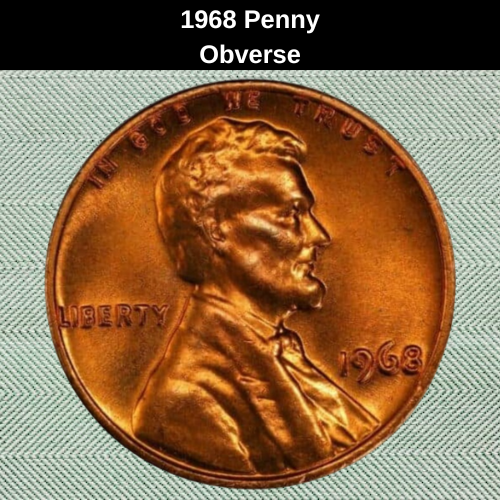
The obverse of the 1968 Lincoln cent features a right-facing portrait of Abraham Lincoln at the center. To the right of the bust, aligned with his chest, appears the year 1968, with the mint mark (either “D” for Denver or “S” for San Francisco) directly beneath it. Coins struck in Philadelphia have no mint mark.
On the left side, behind Lincoln’s neck, you’ll find the word LIBERTY, while the national motto “IN GOD WE TRUST” arches across the top edge of the coin.
One notable feature of this cent is the variation in how the letters of the motto appear — minor differences occurred due to the use of different dies. Additionally, just below Lincoln’s right shoulder, you can spot the initials “VDB”, placed there to honor Victor David Brenner, the original designer of the Lincoln cent introduced in 1909.
The 1968 Penny (reverse)
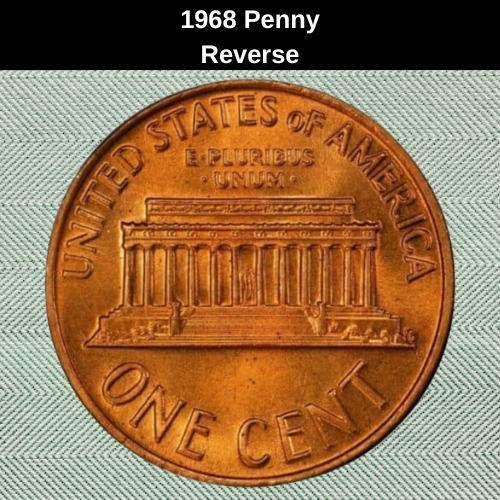
The reverse side of the 1968 Lincoln penny continues the design introduced in 1959. Created by Frank Gasparro, it features the Lincoln Memorial prominently in the center. If you look closely, you can even see a small image of Lincoln’s statue inside the Memorial — a rare case where the same individual appears on both sides of a U.S. coin.
Above the monument is the Latin motto “E PLURIBUS UNUM,” and curving along the top rim is the inscription “UNITED STATES OF AMERICA.” The coin’s denomination, “ONE CENT,” is displayed near the bottom. Gasparro’s initials, “FG,” are located to the right of the Memorial, near its base.
1968 Lincoln Penny Specifications
- Face Value: 1 cent (USD)
- Shape: Round
- Composition: 95% copper, 5% zinc or tin
- Diameter: 0.75 inches (19.05 mm)
- Weight: 0.109 ounces (3.11 g)
- Edge: Plain
- Thickness: 0.059 inches (1.52 mm)
Additional Characteristics of the 1968 Lincoln Penny
The 1968 Lincoln Memorial penny has a round shape and features a plain edge. It measures 0.75 inches (19.05 mm) in diameter and weighs approximately 0.109 ounces (3.11 grams). Composed of 95% copper with small amounts of zinc or tin, this alloy gives the coin a range of color tones, from bright red to deep brown, depending on its condition and storage. The coin’s thickness is around 0.059 inches (1.52 mm).
1968 Penny Grading
The 1968 Lincoln cents, which feature the Memorial on the reverse, were minted in three different locations. Each version—from Philadelphia (no mint mark), Denver (D), and San Francisco (S)—can be found in regular strikes with grades reaching up to MS 67. Rare examples with even higher grades or exceptional features, like deep cameo proof coins, can reach PR 69, although these are increasingly difficult to find today.
Grading follows the Sheldon Scale, ranging from 1 to 70. Here’s a simplified breakdown:
| Grade | Description |
|---|---|
| 1 | Basal State |
| 2 | Fair |
| 3 | Very Fair |
| 4–6 | Good |
| 7–10 | Very Good |
| 12–15 | Fine |
| 20–30 | Very Fine |
| 40 | Extremely Fine |
| 50 | About Uncirculated |
| 60 | Mint State (entry level) |
| 65 | Mint State (gem quality) |
| 70 | Perfect Mint State |
Before determining your coin’s market value, identifying its grade is essential. For basic coins, you can evaluate them yourself using online resources, but for rare or high-value pieces, it’s wise to consult a professional coin grading service.
1968 Penny Value Guides
1968 No Mint mark Penny Value
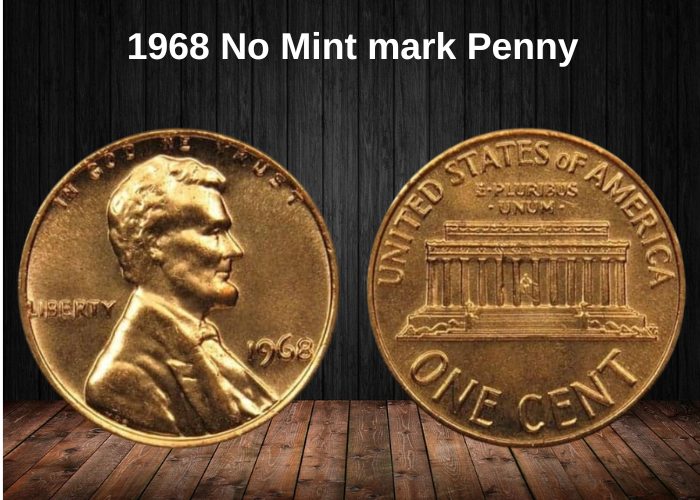
1968 No Mint Mark Penny (Philadelphia) Value
In 1968, the Philadelphia Mint produced over 1.7 billion Lincoln cents without a mint mark. While most of these coins are common and worth less than a dollar in circulated condition, uncirculated examples can carry significant value depending on their grade. Here’s a general price guide based on condition:
- MS 60 – $0.10
- MS 61 – $0.25
- MS 62 – $0.50
- MS 63 – $0.75
- MS 64 – $1.00
- MS 65 – $2.50
- MS 66 – $5.00
- MS 67 – $225 or more
The highest recorded auction price for a 1968 Philadelphia penny is $2,880, achieved in August 2018 for a specimen graded MS 67 RD (Red).
1968 D Penny Value
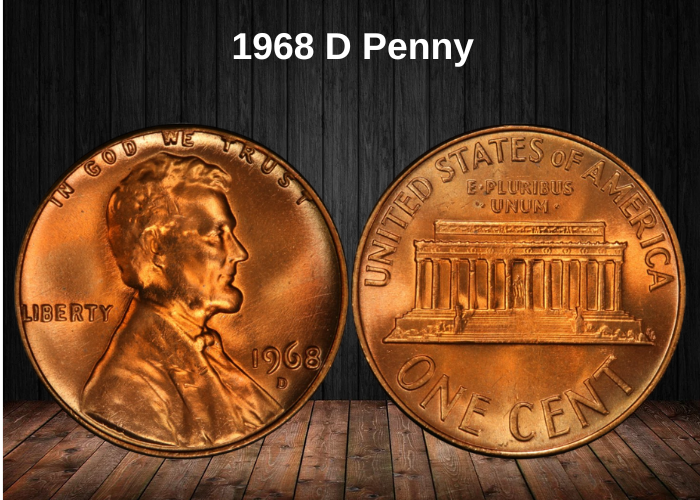
The Denver Mint was the most productive in 1968, striking over 2.8 billion Lincoln cents marked with a “D” mint mark. While these coins are generally common, uncirculated examples can still hold value depending on their condition. Below is the typical value range by grade:
- MS 60 – $0.10
- MS 61 – $0.25
- MS 62 – $0.50
- MS 63 – $0.75
- MS 64 – $1.00
- MS 65 – $2.50
- MS 66 – $5.00
For collectors seeking a 1968-D penny graded MS 67, the price can reach $165 or more. Notably, one MS 67 RD specimen sold for $2,300 at a Baltimore Auction in November 2008.
1968 S Penny Value
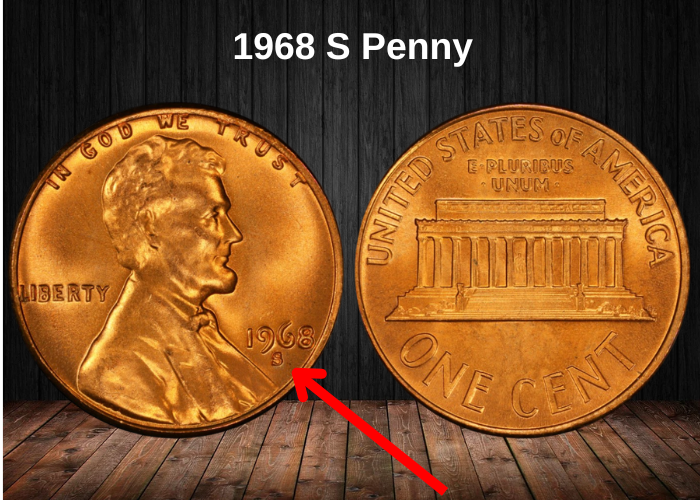
The San Francisco Mint had the lowest mintage of the three facilities in 1968, producing just over 250 million Lincoln cents. Despite being less common, these coins are still affordable in lower grades. Their value increases with condition:
- MS 60 – $0.10
- MS 61 – $0.25
- MS 62 – $0.50
- MS 63 – $0.75
- MS 64 – $1.00
- MS 65 – $2.50
- MS 66 – $5.00
Top-grade examples, like those in MS 67, are valued around $90, though standout specimens have fetched much higher prices. One such coin sold for $499 at auction in April 2013.
1968 Penny Value (proof)
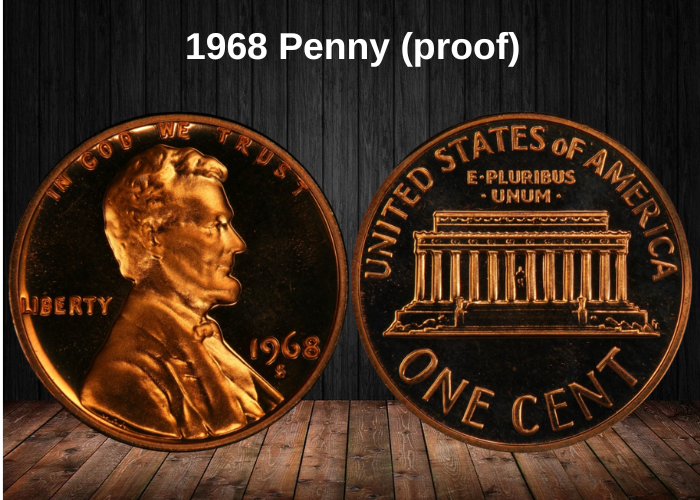
In 1968, the San Francisco Mint produced both circulated and proof coins. The total proof mintage was over three million, which included three varieties: red, CAM (Cameo), and DCAM (Deep Cameo). The price estimates for these proof coins are as follows:
- PR 63 – $7
- PR 64 – $7.50
- PR 65 – $10
- PR 66 – $15
- PR 67 – $25
- PR 68 RD DCAM – $100
The most expensive PR 69 DCAM penny can reach up to $1,650, with the highest recorded sale price of $3,795 in November 2002.
Rare 1968 Penny Error List
Off-center
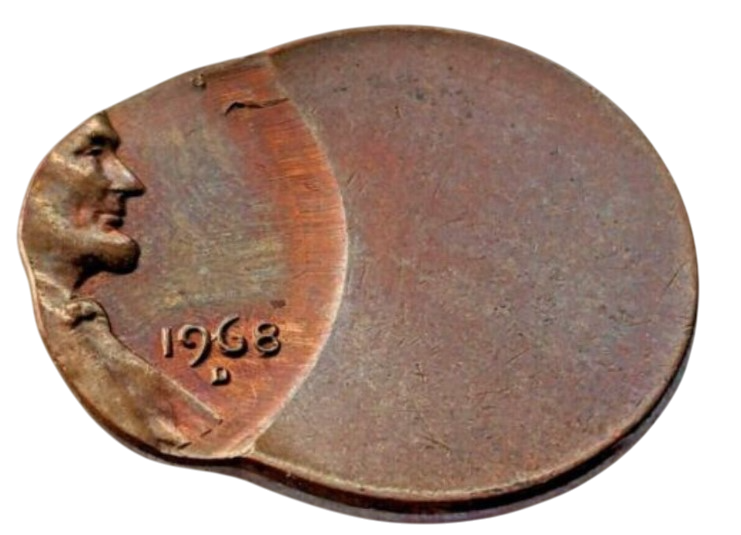
The 1968 off-center penny error occurs when the die strike on a planchet is misaligned, causing the coin’s design to be off-center. This can result in part of the coin’s image being missing, making it an interesting error for collectors.
The degree of misalignment can vary, with more significant off-center errors often commanding higher prices. These coins are generally more valuable than regular-strike pennies because they are considered rarer and more unique. The value of an off-center penny depends on factors such as the degree of misalignment and the coin’s overall condition.
Re-punched Mint Mark (RPM)
The re-punched mint mark (RPM) error occurs when the mint mark is initially struck incorrectly—either upside down or in the wrong spot. To correct this, mint workers would punch the mark again, leading to two or more mint marks being visible on the coin. These types of errors can make the coins more valuable to collectors. For example, a 1968 D RPM penny was sold for $239 on eBay, showing how sought-after these error coins can be.
Doubled Die Reverse (DDR) and Doubled Die Obverse (DDO)
Both DDR (Doubled Die Reverse) and DDO (Doubled Die Obverse) errors occur when a coin’s design is struck multiple times with a misaligned die, causing parts of the design to appear doubled. These errors are relatively common and are sought after by collectors, especially when the doubling is prominent. The more noticeable the doubling, the higher the value of the coin. For example, a 1968 D DDR MS 65 penny with significant doubling was sold for $285 in May 2023.
1968 Penny Struck on a Dime Planchet
One of the rarest minting errors for the 1968 penny is the struck on a dime planchet. This occurs when a penny is accidentally struck on a silver dime planchet, which was used for producing Roosevelt dimes in 1964-1966. This error results in a highly unique coin, as the size and metal composition of the planchet are different from those of a regular penny. These error coins are incredibly rare and much more valuable due to their rarity.
Where to sell your penny?
Now that you know the value of your penny, you might be wondering where to sell it. Don’t worry: here’s a guide to some of the best online platforms where you can easily sell your coins, along with their advantages and disadvantages.
Discover the best platforms for selling coins online (pros and cons).
FAQ About the 1968 Lincoln Penny
1. How did the transition to clad metals in 1968 influence the production of the penny and the history of U.S. coinage?
The 1968 Lincoln Penny was minted during a crucial period in U.S. coinage history. While the 1968 penny still maintained its copper composition (95% copper, 5% tin and zinc), the shift to clad coins (copper-nickel composition) began affecting other denominations (such as dimes and quarters) starting in 1965. This marked a significant change in U.S. coin production, as the rising cost of copper due to global price increases forced the U.S. Mint to seek more cost-effective solutions for coins. This transition to a lower copper content impacted the durability and appearance of coins, which can be observed in the decades that followed.
2. What factors contribute to the abundance of the 1968 penny, and what does this imply for collectors?
With over 2.8 billion 1968 pennies minted at both the Philadelphia and Denver Mints, this is an extremely high mintage. The abundance of this coin means that it is not rare, and while it may be found in circulation or as part of a collection, it doesn’t hold significant value in most cases. For collectors, this high mintage makes the 1968 penny more of a common coin and implies that any examples found in circulated condition will likely be valued only at face value, unless they show significant errors or are in high-grade conditions.
3. How do the varying mintages between the Philadelphia and Denver Mints in 1968 affect the coin’s collectability?
The Philadelphia Mint produced over 1.67 billion of the 1968 pennies, and the Denver Mint produced around 1.22 billion. This disparity in mintage numbers means that while both versions are relatively abundant, the Philadelphia version (without a mintmark) is more common than the Denver version (which bears a D mintmark). For collectors, this means that the 1968 D penny might be slightly more valuable or appealing, but overall, the differences in mintage don’t make either version highly rare. However, collectors who focus on mintmark variations within the Lincoln Memorial series will still find value in both coins.
4. What role do error coins play in the value of the 1968 penny, and why do certain minting errors attract a premium price?
The 1968 Lincoln Penny is often found with minting errors that can significantly increase its value. Common errors include die cracks, off-center strikes, and clipped planchets. These errors are rare, and when found, they create a unique collectible value. Die cracks can make a coin visually distinctive, while off-center strikes and clipped planchets add to the coin’s appeal due to their irregularities. These minting errors are highly sought after by collectors because they represent an anomaly in the minting process, making the coin more historically interesting and potentially worth more than a regular, uncirculated coin.
5. How has the 1968 penny remained a symbol of the Lincoln Memorial series, and what does this continuity mean for numismatics?
The 1968 Lincoln Penny continues the legacy of the Lincoln Memorial design, which was introduced in 1959 and remained in use until 2008. The design, which features a portrait of Abraham Lincoln on the obverse and the Lincoln Memorial on the reverse, holds historical significance as part of a broader tradition in U.S. coinage. For numismatists, the 1968 penny represents an era of stability in U.S. coinage design, serving as a bridge between the traditional use of copper and the eventual shift to clad coins. As such, it’s a key part of the Lincoln Memorial series, which is important for collectors who focus on the evolution of U.S. coin designs.
6. How does the preservation and grading of a 1968 penny impact its value and appeal in the collector’s market?
A 1968 penny that has been well-preserved and graded highly can increase in value, especially in uncirculated or high-grade conditions. Coins that receive a Mint State (MS) grade of MS65 or higher are more likely to attract the attention of serious collectors. Factors such as the coin’s luster, sharpness of detail, and lack of abrasions or contact marks are crucial to its appeal. The 1968 penny, like other common coins, is only valuable in high grades, as its mintage was so high that coins in circulated condition rarely exceed their face value. For collectors focused on high-grade examples of the Lincoln Memorial series, this penny can be an important piece, provided it’s in excellent condition.
7. What challenges exist for collectors who focus on collecting a full set of Lincoln pennies, including the 1968 coin, and how does it fit into the broader context of U.S. coin collecting?
The 1968 penny, while common, is part of a larger challenge for collectors aiming to complete a full set of Lincoln pennies, particularly from the Lincoln Memorial series. While some coins in the series (such as the 1943 steel penny or the 1955 double die penny) are more rare and valuable, the 1968 penny represents an era of large-scale production with limited special varieties. Collectors seeking to complete a set will need to focus on obtaining well-preserved coins, possibly with mint errors, or those in higher grades. Additionally, as part of the transition into clad coinage, the 1968 penny provides context for the evolution of U.S. coinage, making it an important piece in understanding the broader history of U.S. currency and its production.


















































